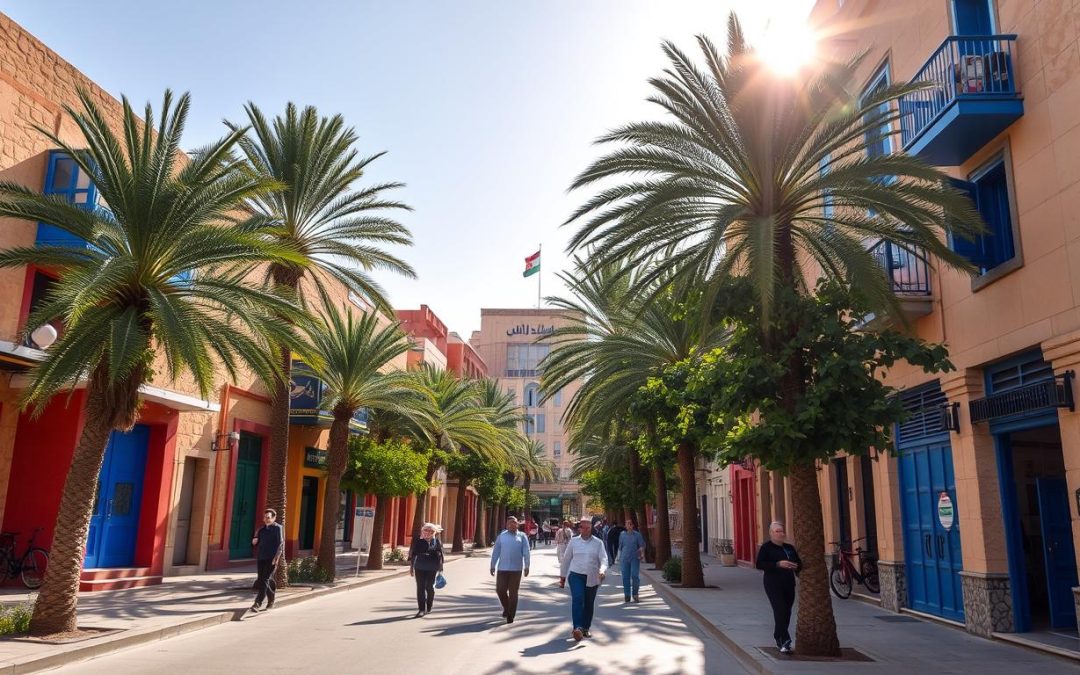Have you ever wondered how a country’s language shapes its identity? In Jordan, the answer lies in its rich linguistic tapestry. This Middle Eastern nation, home to about 10 million people, is a cultural crossroads. Its strategic location connects Africa, Asia, and Europe, making it a hub of diversity.
Arabic is the official language here, used in education, media, and administration. But it’s not just one form of Arabic. The country boasts a variety of dialects, including urban, rural, and Bedouin. Each reflects the unique history and traditions of its speakers.
While Arabic dominates, other languages also play a role. English is widely taught in schools, and minority communities speak languages like Armenian and Chechen. This blend creates a vibrant linguistic landscape that mirrors Jordan’s rich heritage.
Key Takeaways
- Arabic is the official language of Jordan, used in all formal settings.
- The country features diverse Arabic dialects, including urban, rural, and Bedouin.
- English is a key foreign language, taught in schools and universities.
- Minority languages like Armenian and Chechen add to the linguistic diversity.
- Jordan’s location influences its unique blend of languages and cultures.
Overview of Jordan’s Linguistic Landscape
The way people communicate here reflects centuries of cultural exchange. Modern Standard Arabic is the formal language used in education, media, and government. Yet, daily conversations often feature local dialects, each with its own unique flavor.
In urban areas, you’ll notice a distinct dialect compared to rural or Bedouin regions. These subtle differences highlight the diversity within the arab world. For instance, a person in Amman might use phrases unfamiliar to someone in a smaller village.
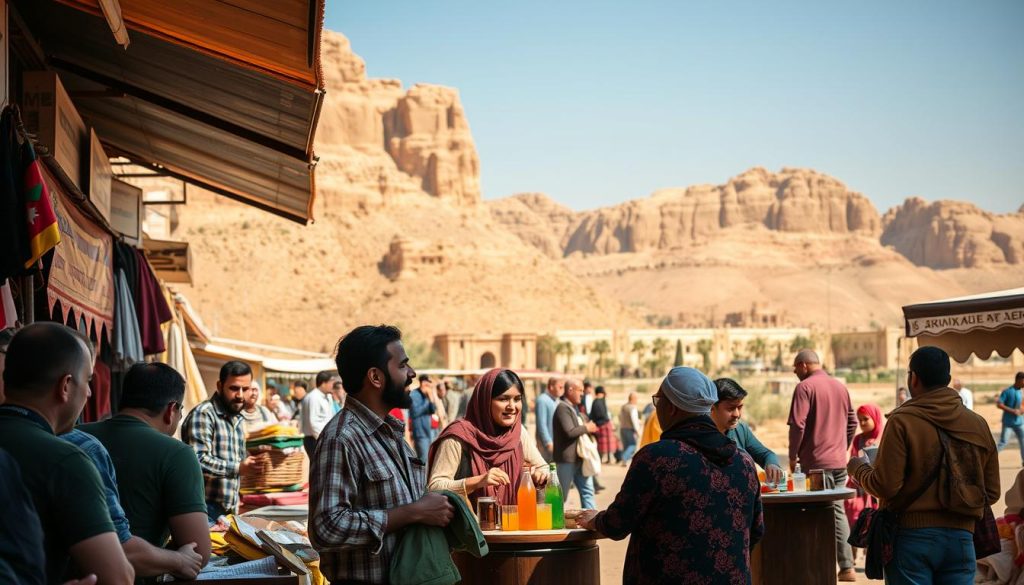
English plays a significant role, especially in education and business. Many schools teach it as a second language, and it’s common in commercial settings. This blend of modern standard arabic and English creates a dynamic linguistic environment.
Historical influences have also shaped the language here. French and Turkish left their mark, adding layers to the local dialects. This mix of influences makes the arab spoken here both rich and complex.
Understanding this linguistic landscape helps you see how language reflects cultural and social identities. Whether it’s formal standard arabic or a casual dialect, every word tells a story.
Official Language: Modern Standard Arabic in Jordan
Language is the heartbeat of a nation, and in this kingdom, it’s no different. Modern Standard Arabic serves as the cornerstone of formal communication. It’s used in government, education, and media, ensuring a unified voice across the country.
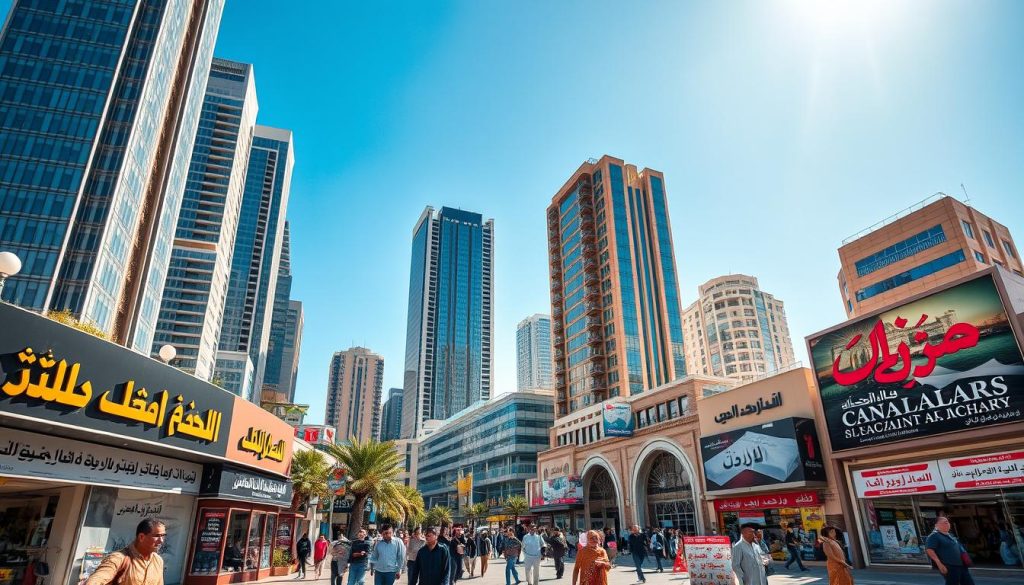
Usage in Education and Media
In schools, modern standard is the language of textbooks and official documents. It’s taught from an early age, helping students master its structure and vocabulary. This ensures that the population can engage with national and regional media, which also rely on this standard form.
Mainstream media, from news broadcasts to newspapers, use modern standard to reach a broad audience. This consistency helps maintain a shared cultural identity across the kingdom.
Modern Standard vs. Colloquial Approaches
While modern standard dominates formal settings, daily conversations often feature local dialects. These colloquial varieties are more relaxed and vary by region. For example, urban areas might use phrases that differ from rural or Bedouin communities.
This duality reflects the kingdom’s rich linguistic heritage. Over the centuries, influences from neighboring regions have shaped both the standard and colloquial forms. Yet, modern standard remains a unifying force, bridging gaps between diverse communities.
“Language is not just a tool for communication; it’s a reflection of who we are and where we come from.”
Understanding this balance helps you appreciate how language shapes national identity. Whether it’s the formal precision of modern standard or the warmth of a local dialect, every word tells a story.
Diverse Dialects: Jordanian Arabic and Bedouin Variants
Dialects here are more than just words; they’re a reflection of heritage. In this region, the way people speak varies widely, shaped by history, geography, and culture. Urban and rural areas each have their own unique linguistic flavors, while Bedouin Arabic stands out for its traditional roots.
Urban and Rural Dialect Differences
Urban dialects have evolved over the years, influenced by migrations and cultural exchanges. Cities like Amman showcase a blend of jordanian arabic with hints of neighboring regions. This mix creates a dynamic, modern way of speaking.
In rural areas, dialects often retain older features. Pronunciation and vocabulary can differ significantly from urban speech. For example, rural speakers might use words or phrases that urban dwellers find unfamiliar.
Nuances of Bedouin Arabic
Bedouin Arabic is a treasure trove of tradition. It’s often spoken in more conservative or royal circles, preserving elements from centuries past. The tonal qualities and vocabulary of this dialect are distinct, reflecting the nomadic lifestyle of its speakers.
This form of jordanian arabic also shows influences from neighboring regions like palestine. It’s a reminder of the shared history and cultural ties across the state.
“Language is the river that carries the stories of a people.”
These dialects are more than just ways of speaking. They’re a testament to the rich cultural identity of this part of the world. Whether urban, rural, or Bedouin, each dialect adds depth to the linguistic landscape.
The Role of English in Jordan’s Society
In a world where communication bridges cultures, English stands out as a vital link in this region. Though not the official language, it plays a key role in education, business, and tourism. Its influence stems from a legacy that continues to shape modern practices.
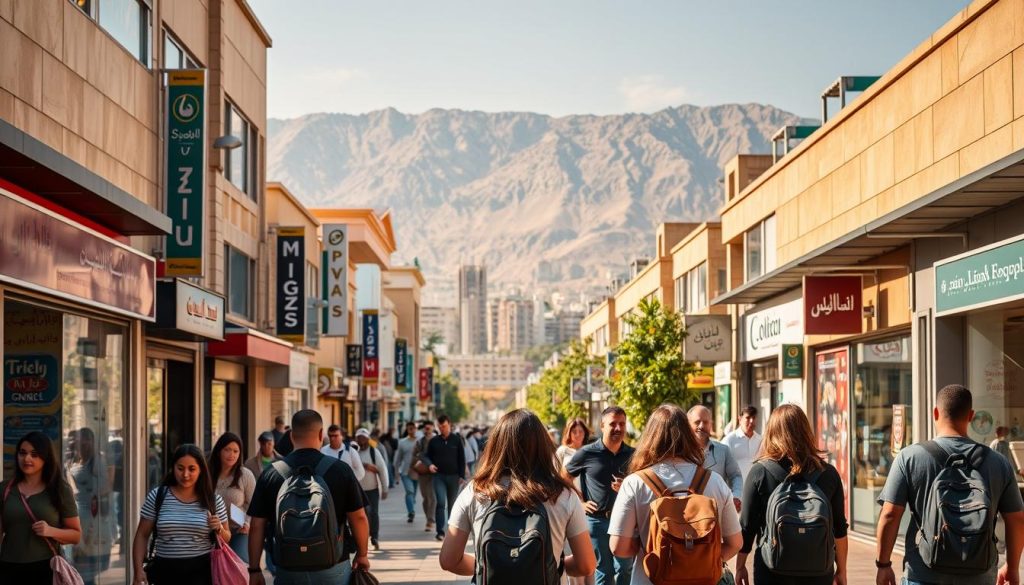
Impact on Business, Education, and Tourism
English is deeply integrated into the educational system. Schools teach it from an early age, and universities offer extensive programs. This focus prepares students for global opportunities, making it a cornerstone of modern education.
In business, English serves as a common language for international trade. Companies in the middle east often use it to communicate with partners worldwide. This practice highlights its importance in the region’s economic growth.
Tourism also benefits from widespread English usage. Visitors from the east and south find it easier to navigate and interact with locals. This linguistic bridge enhances the travel experience, boosting the sector’s success.
“Language is the key to understanding and connecting with the world.”
The legacy of British influence has made English a tool for global engagement. Its pervasive use reflects a commitment to modernization and international communication. This approach ensures that the region remains connected to the global community.
| University | 2007-2008 | 2012-2013 |
|---|---|---|
| Jordan University | 435 | 717 |
| Irbid National University | 617 | 377 |
| Gadara University | 636 | 289 |
| Yarmouk University | 467 | 744 |
| Al Al-Bayt University | 387 | 816 |
English’s role in this region is more than just practical—it’s a reflection of a forward-thinking society. From classrooms to boardrooms, it shapes daily life and opens doors to the world.
French and Minority Languages in Jordan
Language diversity in this region goes beyond the mainstream, reflecting a blend of global and local influences. While Arabic and English dominate, minority languages like French, Armenian, Circassian, Tagalog, and Russian add unique layers to the cultural fabric.
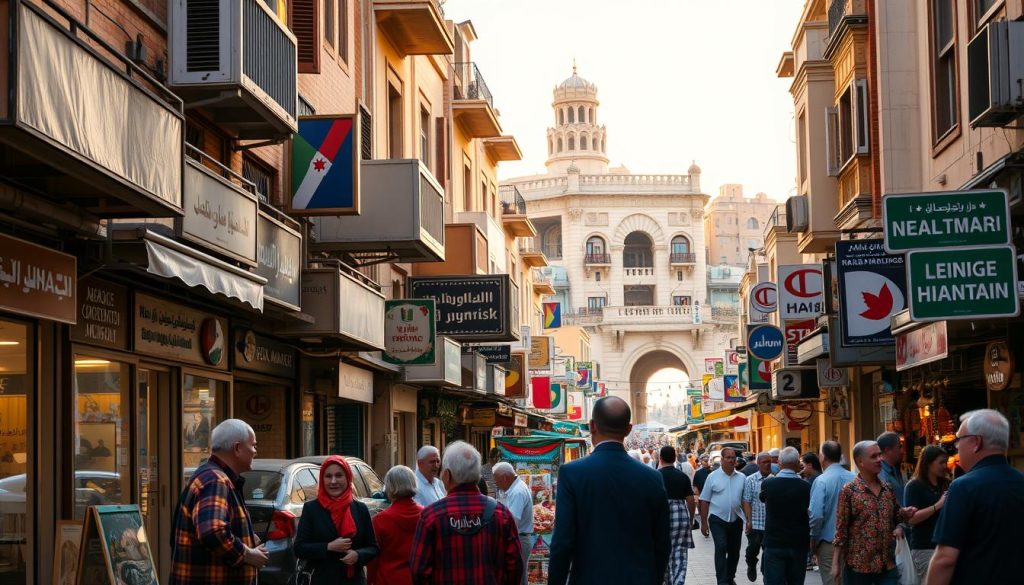
Cultural Preservation and Global Influence
French holds a special place as a language of culture and commerce. It’s taught in select schools and universities, often chosen by those with an interest in European heritage. This connection to arabia and beyond highlights the region’s openness to global exchange.
Minority communities, such as Armenians and Circassians, maintain their native tongues. These languages are more than just communication tools—they’re a way to preserve identity and heritage. For example, Armenian is spoken in homes and cultural events, keeping traditions alive.
Tagalog, spoken by Filipino workers, is another example of linguistic diversity. It’s a reminder of the region’s role as a hub for international labor. Similarly, Russian is spoken by older generations who studied in the USSR, adding another layer to the linguistic mosaic.
“Every language is a treasure chest of history and culture, waiting to be opened.”
These languages complement Arabic and English, enriching the region’s cultural landscape. They also reflect the influence of neighboring regions like israel and the broader arabia. In urban centers, this blend is particularly evident, where international influences shape daily life.
Maintaining these languages showcases the region’s commitment to cultural diversity. It’s a testament to the idea that language is not just a means of communication but a bridge to understanding and preserving heritage.
Jordan: Official and widely spoken languages
From the desert to the city, dialects tell the story of this land. The linguistic landscape here is a vibrant mix of tradition and modernity. Arabic stands as the official language, but its dialects vary widely, reflecting the region’s rich history.
Pronunciation differences add depth to the spoken word. Urban areas often use a modern dialect, while rural and Bedouin communities preserve older forms. These variations highlight the cultural diversity of this Arab country.
Language unites people across the middle of this diverse nation. In cities, you’ll hear a blend of Arabic and English, while the desert echoes with traditional Bedouin speech. This blend of modern and traditional practices creates a unique linguistic identity.
For every woman and man, language is a cornerstone of identity. It bridges gaps between generations and regions, fostering a sense of unity. Whether in the bustling city or the quiet desert, words carry the essence of this land.
“Language is the thread that weaves the fabric of a nation.”
This Arab country embraces its linguistic diversity as a hallmark of its heritage. From the classroom to the marketplace, language shapes daily life. It’s a testament to the enduring power of communication in this middle of cultural crossroads.
| Region | Dialect | Characteristics |
|---|---|---|
| Urban | Modern Arabic | Blend of traditional and modern phrases |
| Rural | Traditional Arabic | Older vocabulary, slower pronunciation |
| Desert | Bedouin Arabic | Preserves ancient tonal qualities |
In this land, language is more than words—it’s a reflection of identity. From the desert to the city, every dialect tells a story. This blend of tradition and modernity makes this Arab country a linguistic treasure.
Cultural Significance: Language and Identity in Jordan
Language in this region is more than just words—it’s a bridge to identity and heritage. It shapes how people see themselves and connect with others. From the bustling streets of Amman to the quiet desert landscapes, every word carries meaning.
Language as a Unifying Factor
Arabic serves as a unifying force, bringing people together despite their differences. Whether you’re a member of a Bedouin tribe or a city dweller, it’s a shared thread. This common language fosters a sense of belonging and pride.
Historical roots, like the influence of moab and neighboring regions such as palestinian and iraq, continue to shape the way people speak. These connections highlight the region’s rich cultural tapestry.
Traditions Interwoven with Modern Influences
Traditional expressions coexist with modern adaptations, creating a unique linguistic blend. For example, ancient proverbs are still used in daily conversations, while new slang emerges in urban areas. This balance reflects the region’s ability to honor its past while embracing the future.
Language also acts as a bridge, connecting people to their home and heritage. For palestinian refugees, it’s a way to preserve their identity. For others, it’s a reminder of their roots in places like moab or iraq.
“Language is the soul of a culture, carrying its stories and traditions across generations.”
Cultural content and traditions are deeply embedded in the way people express themselves. Whether it’s through poetry, music, or everyday speech, language is a powerful tool for preserving and sharing heritage.
Conclusion
At the crossroads of asia, Africa, and Europe, language serves as a mirror of cultural identity. The blend of Arabic, English, and minority tongues reflects a rich heritage and a forward-looking society. Arabic, with its diverse dialects, remains the cornerstone of daily life, while English bridges global connections.
Minority languages like French and Armenian add layers of cultural depth. They preserve traditions while enabling modernization. This linguistic diversity showcases a commitment to inclusivity and heritage.
Language is more than communication—it’s a bridge to understanding. It connects people across regions and generations, fostering unity in diversity. As you explore this cultural tapestry, you’ll see how words shape identity and reflect history.
Appreciating this linguistic mosaic offers a deeper understanding of a nation at the heart of asia. It’s a testament to the enduring power of language in preserving culture and building connections.
The above is subject to change.
Check back often to TRAVEL.COM for the latest travel tips and deals.
Here are some Tours & Sightseeing suggestions that might pique your interests!
